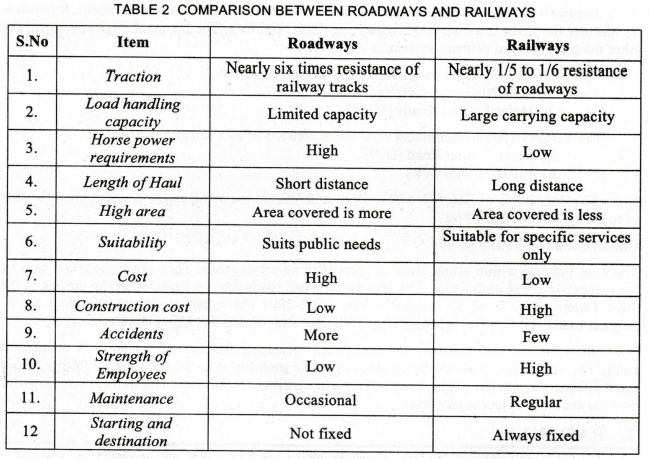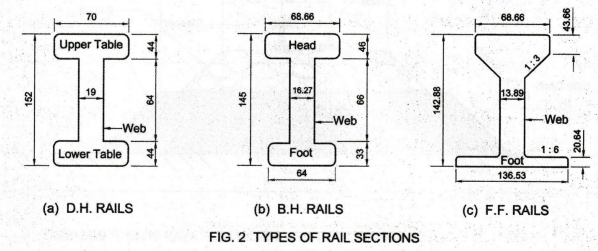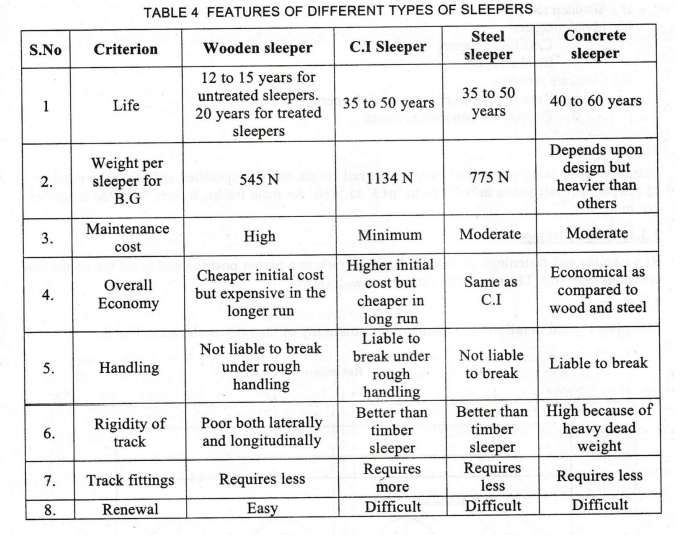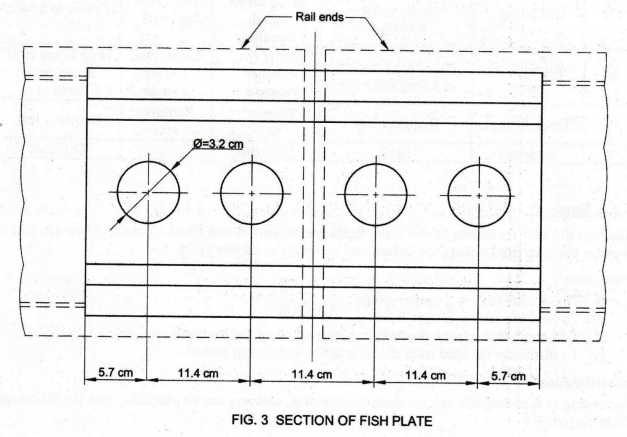Basic Civil & Mechanical Engineering: UNIT III: m. Highway and railway an introduction
Railway
Advantages, Requirements and Components of Railway Track
Railways form the most important mode of transport in India. Railways have brought about many political, social and economic changes in the life of Indian people. The network of Indian Railways is divided into nine zonal divisions for administrative purposes.
RAILWAY
1. INTRODUCTION
Railways
form the most important mode of transport in India. Railways have brought about
many political, social and economic changes in the life of Indian people. The
network of Indian Railways is divided into nine zonal divisions for
administrative purposes.
TABLE
1 ZONAL DIVISIONS OF INDIAN RAILWAYS

TABLE
2 COMPARISON BETWEEN ROADWAYS AND RAILWAYS

Advantages
of Railways
Railways
have the following advantages over other modes of transport:
•
Migration of people on a mass scale
•
Mobilising troops during war periods
•
Large scale movement of commodities
•
Encourages commercial unity
•
Stabilisation of the prices of commodities
•
Ensures safe and comfortable journey
•
Easy access to major places of tourist attraction
•
Development of a nation
2. RAILWAY TRACK (PERMANENT WAY)
he
combination of rails, fitted on sleepers and resting on ballast and formation
is called the railway track or permanent way. Sometimes temporary tracks are
also laid for conveyance of earth and materials for construction work. The name
permanent way is given to distinguish the final layout from these temporary
tracks.

Requirements
of a Permanent Way
In
order to achieve higher speed and better ride qualities with less maintenance
in future, the following requirements of a permanent way are to be met:
1.
Gauge should be correct and uniform.
2.
Rails should be in proper level.
3.
Alignment should be correct, i.e. it should be free from kinks or
irregularities.
4.
Gradient should be uniform and any change of gradient should be followed by a
smooth vertical curve.
5.
Track should be resilient, i.e., there must be a certain amount of elasticity
in the track.
6.
Radii and super elevation on curves should be properly designed and maintained.
7.
Joints, the weakest points in the railway track should be properly designed and
maintained.
8.
Drainage system should be perfect.
3. COMPONENTS OF A RAILWAY TRACK
1.
Rails
The
rails on the track can be considered as beams carrying loads. They are made of
high carbon steel to withstand wear and tear.
Functions
of Rails
a)
To provide a hard, smooth and unchanging surface for the passage of heavy
moving loads with minimum friction between the steel rails and steel wheels.
b)
To bear the stresses developed due to heavy vertical loads, lateral and braking
forces as well as thermal stresses.
c)
To transmit the load to sleepers and consequently reduce pressure on ballast
and formation.
Types
of Rail Section
The
types of rail section are Double headed rails (D.H. rails), Bull headed rails
(B.H. rails) and Flat footed rails (F.F. rails) as given in Fig. 2.

Rail
track is subjected to bending stress when a train moves over it. Bending stress
is higher at the top and bottom sides of the cross-section than at the
mid-portion of the section as explained in Section 4 of Chapter 1. Hence, I-section
is preferred for rails and in construction since the section has more material
where bending stress is higher. Thus, the I-section is more economical since it
reduces the weight of rail or beam.
In
India, flat footed rails are most commonly used because they have more strength
and stiffness, both vertically and laterally than B.H. rails. Fitting of rails
with sleepers is simpler and as such they can be easily laid and re-laid.
Gauge
Rail
gauge is the distance from the inside of one rail on a railroad track to the
inside of the other. The widths of different gauges of rails are given in Table
3.
TABLE
3 WIDTHS OF DIFFERENT GAUGES

2.
Rail Joints
The
weakest point of track is the joint between two rails. An ideal or perfect rail
point is one which provides the same strength and stiffness as the other
sections of the track.
TABLE
4 FEATURES OF DIFFERENT TYPES OF SLEEPERS

3.
Sleepers
Sleepers
are laid transverse to the rails. Rails are supported and fixed on them. They
are laid to transfer the load from rails to the ballast and subgrade as shown
in fig. 1.
Functions
i)
To hold the rails to a proper gauge
ii)
To hold the rails at proper level
iii)
To interpose an elastic medium in between the ballast and rails
iv)
To distribute the load from the rails to the underlying ballast
Classification
According
to the materials used in their construction, sleepers can be classified into
the following three classes:
i)
Wooden sleepers
ii)
Metal sleepers
a.
Cast iron sleepers
b.
Steel sleepers
iii)
Concrete sleepers
a.
Reinforced cement concrete sleepers
b.
Prestressed concrete sleepers
Sleeper
Density
Sleeper
density is the number of sleepers per rail length and it is specified as (n+x).
The number of sleepers per rail varies in India from ‘n+3' to 'n+6' for main
tracks, where, 'n' is the length of rail in meters.
4.
Track Fittings
Rail
fixtures and fastenings are used to keep the rails in a proper position and to
set the points and crossings properly. The major rail fittings are as follows:
1.
Fish Plate
Fish
plate is used in rail joint to maintain the continuity of the rails as shown in
Fig. 3.

The
requirements of fish plate are:
1.
To support the underside of the rail and top of the foot
2.
To allow for free movement of rails for expansions and contractions
3.
To hold the ends of the rail both laterally in line and vertically in level.
4.
To withstand the stresses due to bending moments without getting distorted
5.
To absorb shocks caused by the jumping of the wheel over the expansion gap.
2.
Spikes
Spikes
are used for holding the rails to the wooden sleepers. The characteristics of a
good spike are:
1.
It should be strong enough to hold the rail in position
2.
It should be as deep as possible.
3.
It should be easy to fix and remove from the sleepers
4.
It should properly maintain the gauge.
3.
Bolts
Bolts
are used for fastening various components of railway tracks. For example, fish
bolts are used to connect fish plates with the rail. Four bolts are used at
each joint.
4.
Chairs
In
case of double headed and bull-headed rails, chairs are required to hold them
in position. They help in distributing the load from the rails to the sleepers.
5.
Keys
Keys
are small tapered pieces of timber or steel to fix rails to chairs on metal
sleepers.
6.
Bearing
Plates
Bearing plates are rectangular plates made of M.S or C.1. They are used below
flat-footed rails to distribute the load on a larger area of timber sleepers.
5.
Ballast
Ballast
is the granular material usually comprising broken stone or brick, shingle or
kankar, gravel or sand placed and packed below and around the sleepers (Fig.
1). The functions of ballast are given below:
1.
It is used to transmit load from sleepers to formation and allow drainage of
the track.
2.
It provides a suitable foundation for the sleepers.
3.
It holds the sleepers in their correct position by preventing their
displacement by lateral or longitudinal thrusts.
4.
Lateral stability of a track depends on the ballast.
Size
and Quantity of Ballast
The
size of stone ballast varies from 19 mm to 51 mm with a reasonable proportion
of intermediate sizes. The depth of the ballast is defined as the distance
between the bottom of sleeper and top of subgrade.
Subgrade:
It is the naturally occurring soil, prepared to hold the ballast, sleepers and
rails for constructing the railway track. This prepared surface is also called
formation. Formation could be in embankment level or cutting, depending upon
the ground condition.
Embankment:
It is a raised bank of earth or other materials constructed above the natural
ground. It is constructed when railways have to be carried in lower grounds or
valleys.
Cutting:
It is raised ground or hill, cut or excavated, for constructing the railway
line at the required level below ground level.
Formation:
The prepared surface which is ready to receive ballast is called formation. The
stability of the track depends upon the quality of the formation under it.
The
formation for a track is obtained by either constructing an embankment or
cutting. Formation performs the following functions:
1.
It bears the load transmitted to it through the ballast in a uniform manner.
2.
It prevents the ballast from punctuating into it.
3.
It drains off the water entering from its top
4.
It provides a smooth regular and graded surface on which the ballast and the
track may be safely rested.
5.
It does not change its volume due to variation in moisture. Otherwise, it would
induce stresses on the track and disrupt the track.
Basic Civil & Mechanical Engineering: UNIT III: m. Highway and railway an introduction : Tag: : Advantages, Requirements and Components of Railway Track - Railway
Related Topics
Related Subjects
Basic Civil and Mechanical Engineering
BE3255 2nd Semester 2021 Regulation | 2nd Semester EEE Dept 2021 Regulation
